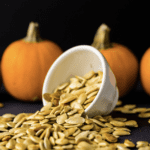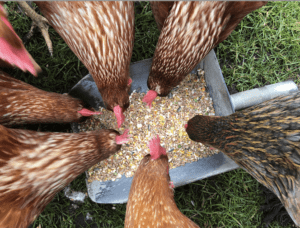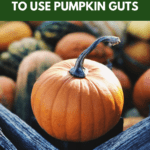October 25, 2023
5 Earth-friendly Ways to Use Halloween Pumpkin Guts
5 Earth-friendly Ways to Use Halloween Pumpkin Guts
It’s pumpkin carving time! But what happens after pumpkins are carved, displayed, and start to rot?
Just like all other food “waste,” when pumpkins end up in a landfill, they generate greenhouse gasses that don’t belong in our atmosphere in excess. Not only that, their capacity to regenerate healthy soil is halted, because they’ve been removed from nature’s powerful decomposition cycle.
There are plenty of ways to make sure that doesn’t happen.
After Halloween is over and your Jack-o-lanterns get saggy, there are still ways to make sure that rich organic material doesn’t end up in a landfill. Read on to learn some clever ways of upcycling pumpkins of all varieties.
1. Roast The Seeds
This one’s a classic and kids love it! As you scoop your pumpkin for carving prep, set the “guts” aside in a bowl. Separate seeds from the pumpkin strings and gooey flesh and place the clean seeds on a cookie sheet. Let dry while you carve your pumpkins.
When seeds are dry, toss them in olive oil and spread them out on the baking sheet, spaced as evenly as possible. Sprinkle with salt and any other spices
Roast at 350 degrees for 40 minutes or until golden brown.
Here are a couple of our favorite roasted pumpkin seed recipes:
- Basic Pumpkin Seed Roasting Recipe from The New York Times
- Sweet & Salty Pumpkin Seed from Phyllis Grant at Food52
Roasted pumpkin seeds with just a little salt make a tasty treat, but you can also use the roasted seeds to make:
- A seed, fruit, and nut mix — try spicy or salty-sweet flavors
- Pumpkin seed pesto or hummus
- A crunchy topper for salads and soups
2. Make Pumpkin Stock

But if your pumpkins are totally rot-free, haven’t been exposed to extreme temperatures, and uncarved, there are plenty of delicious ways to turn most parts of a pumpkin into food.
For stock: After carving or when you’re done displaying pumpkins, chuck the insides in a big stock pot. Add any other veggies or veggie scraps you may have, including onion, celery, garlic, and carrots. Cover with water and a bay leaf or two, and perhaps a little salt.
Simmer on the stove for several hours. Strain out veggies, pouring into a jar. Seal and refrigerator (use within 4-5 days) or freeze it for up to 5-6 months. Or use the stock right away for soup or risotto!
Homemade pumpkin puree can be used in recipes for breads, cookies, or muffins that call for canned pumpkin. It can be frozen and thawed for future use, too.
What kind of pumpkins are edible?
Good news: most pumpkins are edible. Even pumpkin types bred as common Jack-o-lanterns can be eaten — but these have been bred for visual apparel rather than taste and nutrition, so stick to baked goods when you cook those. Plenty of pumpkin varieties are grown specifically for eating, so choose those if you’re interested in making soup or a roast.
3. Save The Seeds for Planting
Save your seeds to grow your own pumpkins in your garden next year. Follow the steps above to remove and separate the pumpkin insides and seeds. Lay clean seeds on a tray and cover with a paper towel or light cotton rag.
Let seeds dry very well, keep them out of direct sunlight and away from dramatically varying temperatures.
Once seeds are dry, seal them in a plastic bag, envelope, or other sealable container and keep them in a cool, dry location protected from direct sunlight.
4. Compost
Home gardeners know the best way to keep your pumpkin out of a landfill is to use it to enrich your garden. If you have a high-functioning home compost operation, pumpkins are awesome additions to the pile.
A few tips for composting your Halloween pumpkin:
- Remove all candles, wax, or other non-organic materials
- Never compost painted pumpkins
- If you garden organically (and we hope you do!), be sure your pumpkin was grown on an organic farm
- Remove the seeds before composting — unless you want your compost pile to become your pumpkin patch next spring
- Chop the pumpkin(s) into chunks before you tossing in the compost heap so it will break down quicker
- Balance the big dose of organic material (or “green” material) with a carbon-rich (brown material) addition, like leaves, newspaper, or wood ash
- If you don’t have a home compost, there may be a local organization that will happily take it for compost or food for livestock.
Do a quick internet search for “donate old pumpkins near me” and you’ll probably be surprised. Plenty of farms, animal shelters, and non-profit orgs around the country collect used Halloween pumpkins.
5. Feed The Wildlife…Or Your Chickens!
Local wildlife would love to snack on your pumpkins! Even if your pumpkins are a little soggy, everyone from bluejays to deer will be happy for the nutritious late-fall meal.
We recommend only feeding organic pumpkins to wildlife, since harsh chemical fertilizers can be harmful to animals. Also, don’t feed painted pumpkins to animals.
Make a cute pumpkin bird feeder by cutting off the top half of the carved pumpkin, filling the bowl with bird seed, and hanging it from a tree or placing it on a fence. Get ready to admire migrating flocks as they take a break in your wildlife paradise.
For foraging four-legged animals like squirrels, rabbits, and deer who are preparing for a long winter, cut your pumpkins into chunks and scatter them at the edges of your yard. Avoid this if you have a rat problem!
If you’ve got chickens in the backyard, we don’t need to tell you how much your flock will love pumpkin remains.
Happy Halloween!
Show us your True Organic Plants
#GrowWithTrue
www.trueorganic.earth





